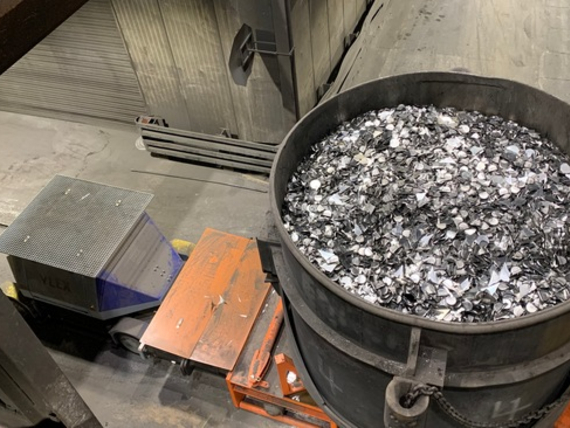ESF Elbe-Stahlwerke Feralpi GmbH in Riesa (steel mill), Saxony, has specialized in the production of high-performance steel products for the construction industry and infrastructure. Tons of scrap parts are regularly delivered to this site, which are first melted and then transformed into billets, bars or mats of steel. This is not only efficient but also particularly sustainable: 93.4 percent of FERALPI STAHL's products are made from recycled material.
Once delivered to Feralpi, the rail cars loaded with scrap have to be unloaded and moved as quickly as possible by excavator or crane to the production hall in Riesa so as to avoid blocking the rail through traffic there. In this process one person is responsible for both the unloading and the shunting of the wagons.
Remote controlled shunting of the wagons
For this reason, Vollert used the VLEX 40 road-rail vehicle for Feralpi. The maneuverable shunting solution for rail and road is not only able to move heavyweights, but is also operated via remote control. At Feralpi, this shunting process is monitored by an employee in scrap logistics. First, the operator unloads the wagons prior to activating the VLEX 40 via radio control to move the freight wagons. To ensure optimal visibility at all times, Vollert equipped the shunting vehicle with a camera system for the first time. "The camera images are played back on the remote control display, similar to a rear view camera in a car. This guarantees a clear view when the VLEX is in motion," explains Michael Spohn, Project Manager Sales at Vollert.
Fast and safe location changes
The VLEX 40 moves the 500-ton rail cars without any effort: With a tensile load of over 40 kN and a dead weight of 10 tons, the road-rail robot is suitable for heavy materials weighing up to 600 tons. Its sophisticated vehicle geometry with articulated steering and four individually controlled wheel hub motors ensure that it makes the change from track to road particularly maneuverable and economical. Hydraulically lowering track guide rollers for rail travel and an oscillating axle guarantee continuous ground and rail contact for all four wheels, regardless of the surface. "In other words, the VLEX can change or leave the tracks at any time, which are thus free again for through traffic after a short time," says Marco Kießling, head of scrap control at Feralpi, summarizing the advantage as another benefit.
Travel to the Melting Furnace at VDM Metals
For the further processing of discarded metals, Vollert has also found a solution in terms of intralogistics for the internationally active manufacturer of corrosion- and heat-resistant high-performance materials VDM Metals. At the site in Unna in North Rhine-Westphalia, nickel materials and special stainless steels are openly melted from scrap and virgin metals in an arc furnace. In the form of ingots and blocks, these are later used to produce sheets, strips, bars, forgings and wires.
VDM Metals was looking to make the in-plant shunting of scrap baskets more efficient and flexible. Previously, a rail-based shunting vehicle equipped with an additional trailer for a second scrap basket transported the metals to the melting furnace. "However, the transport equipment, which was getting on in years, was now proving to be particularly prone to breakdowns," reports Uwe Neuhaus, project manager in maintenance at VDM Metals. "The high level of maintenance regularly led to stoppages on the 40-m-long track. Therefore, Vollert was originally supposed to design a similar new vehicle for us." But the engineers had a more cost-effective combination in mind with the VLEX shunting robot and two transport carriages. "The carriages should remain rail-based, while the shunting vehicle should be flexible," says Michael Spohn, clarifying the idea. "In this way, the VLEX also offers the possibility of taking over further transport tasks in the operation aside from the rail track."
With Tensile Strength and Impact Protection
The strong tractive force and robustness of the VLEX 20 also pays off in this transport operation: First, the two buckets are loaded with scrap parts by a crane with an electromagnet. The VLEX 20 then moves the two transport carriages to a blast furnace, where another crane empties the buckets and puts them back again. In total the VLEX 20 pushes 100 tons - 50 tons per bucket. There is even further room for improvement here, as the VLEX 20 has a tractive force of up to 300 tons. In order to be able to move such loads, its manufacture must be particularly robust. This means that even the high dust levels in the meltshop cannot harm it. In addition, it has been provided with impact protection against falling metal parts for use at VDM Metals. The vehicle itself does not contribute to further pollution or hazards: Thanks to its exhaust-free electric drive, it can be used in enclosed storage and production areas without any problems.
Due to the defined travel path, the travel of the VLEX in Unna also takes place automatically. Control is possible from three stationary control panels - at the loading point, at the unloading point and on a furnace bridge. A scanner on the VLEX continuously monitors the travel paths and stops the vehicle if foreign objects, such as metal or scrap parts lying around, are detected. Intra-plant passenger traffic is controlled by a traffic light system during travel.





